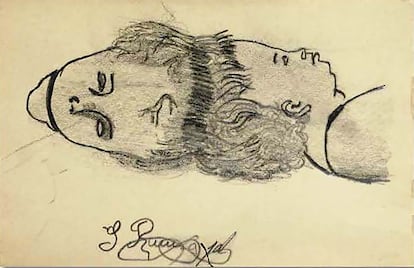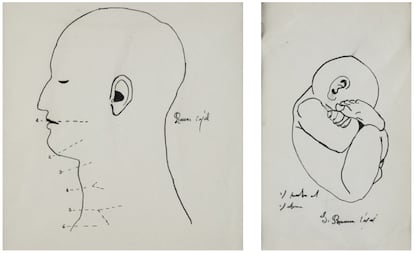A scammer once again sneaks cheap forgeries of Cajal drawings into an auction house.

The Ansorena auction house, one of Spain's oldest, has withdrawn ten botched forgeries of drawings by Nobel Prize winner Santiago Ramón y Cajal that it had put up for sale with a starting price of €1,000, a company spokesperson confirmed to EL PAÍS. The lot included supposed studies of the human body and a very crude imitation of one of the scientist's most famous works: a neuron drawn in 1906, so well-known that it even appeared in an episode of the American television series The Big Bang Theory . Cajal won the Nobel Prize in Medicine that year for demonstrating that the human brain is organized into these independent cells. His priceless original drawings are renowned and have been exhibited at institutions such as the Peabody Museum in the United States andImperial College London .
Chemical engineer Marcos Larriba , author of the book "Ramón y Cajal. The Decline of Genius " (Amarante publishing house), sounded the alarm on Monday on social media after learning about the auction of the drawings. "They are the work of a forger who has been imitating the work and its signature for years," he warned. Larriba has spent almost a decade following the trail of this mysterious swindler. He says the first time he came across similar fake drawings was in a shop at the Rastro flea market in Madrid on Calle Mira del Río Baja, around 2017. There were several for sale, hanging on a wall.
At the end of June 2017, the University of Zaragoza Library announced that it had acquired an original drawing by Cajal, titled "Individuo bicéfalo" (Bicephalous Individual ), which depicted two joined heads and allegedly bore the scientist's signature. "The drawing is related to Cajal's studies on embryology and shows us his dual artistic and scientific side," the university proclaimed in a statement at the time. Larriba warned the institution that they had fallen for a scam. The signature didn't even resemble Cajal's. The forgery went on sale for 70 euros at the Madrid auction house El Remate .

A spokesperson for the University of Zaragoza explains that the institution bid up to 170 euros. "At the time of the acquisition, Cajal's authorship was considered credible, especially given the auction house's website where it was advertised," the same source states. A university researcher raised the alarm months later that it was possibly a forgery. "Despite the doubts, no police report was filed, pending irrefutable proof of its forgery, and the Library has continued to hold the drawing in custody, although, due to the doubts that arose, the drawing has never been exhibited," the spokesperson adds.
“I would say the author is always the same,” says Larriba, a professor at the Complutense University of Madrid. “There must be 20 or 30 fake drawings circulating, for sure,” he opines. This academic detective has also found these crude forgeries on buying and selling platforms such as Todocolección and Wallapop. At the Barcelona auction house Soler y Llach, an attempt was made to sell a supposed Cajal sketch , which was actually a child's tracing of a 16th-century illustration of a human torso. When the enigmatic swindler attempts to imitate an original Cajal work, the result, in the eyes of any expert, is the scientific equivalent of the disastrous restoration of Borgia's Ecce Homo .
The quality of the drawings is so poor that it discredits the authentication protocols of the companies involved, as several experts have denounced on social media. “What rubbish. I hope Ansorena withdraws them immediately and does not collaborate in a scam,” warned neuroscientist José Ramón Alonso , a professor at the University of Salamanca, on Monday. “I see it and I don't believe it. If this is how they authenticated Cajal's drawings , why should we trust the rest?” criticized neurologist David Ezpeleta , vice president of the Spanish Society of Neurology. An Ansorena spokesperson told this newspaper that the auction house's policy is not to reveal the identity of the owners of the works for sale.
“He's been falsifying drawings for years. He's very bad, but if he continues it's because he sells them. They must be fools,” said neurobiologist Juan Andrés de Carlos on Monday. For two decades, he was responsible for the so-called Cajal Legacy : almost 30,000 pieces, mostly drawings of nerve cells, brain slices, manuscripts, and astonishing photographs, which are now housed at the National Museum of Natural Sciences in Madrid, awaiting the fulfillment of Pedro Sánchez's government's promise to create a Cajal Museum . “Ansorena, take this rubbish away!” cried De Carlos. The neurobiologist, from the Cajal Institute, told EL PAÍS that one day a man showed up at his center with an obviously falsified drawing that he had bought for his grandson, a medical student. “It hurt me a lot to have to tell him it was a fake,” he laments.

Eight months ago, the Madrid auction house Segre asked Larriba about a drawing attributed to the Toledo sculptor Víctor González Gil , which allegedly featured a dedication written by the scientist, but in handwriting similar to that of the mysterious swindler: "Thank you for your collaboration / Víctor my friend / 1931." Cajal was then a sick and deaf pensioner, who at 79 had reduced his contact with the world to a minimum. The artist was a 19-year-old Fine Arts student. The relationship between the two is unlikely. Larriba replied : "In my opinion, that handwriting and signature have nothing to do with Santiago Ramón y Cajal." "I have never seen a dedicated Cajal drawing, much less a drawing by another artist," he stated. The professor explains that they ignored his assessment and sold it for 600 euros . The Segre auction house, which defended its authenticity, now has another work by the Toledo artist for sale for 700 euros with another alleged Cajal dedication. This newspaper asked two Segre catalogers on Tuesday night if they were aware of this possible fraud, but has not received a response so far.
The Nobel Prize winner himself denounced the use of his name for all kinds of scams in a letter published in the newspaper El Sol on April 22, 1926. It was titled: "How my modest name is exploited by certain unscrupulous industrialists." His signature appeared in a multitude of advertisements at the time. "This abuse committed by some industrialists consists of gratuitously attributing to me the execution of specific analyses of medicinal wines, mineral waters, disinfectants, rolling papers, toothpastes, and other products that I have never heard of," Cajal complained. "The aforementioned industrialists, then, should rectify their conduct toward me. Erase my name from their claims and labels [...]. I appeal to your rectitude and nobility."
Do you have more information about this or similar cases? You can write to us at [email protected]
EL PAÍS





